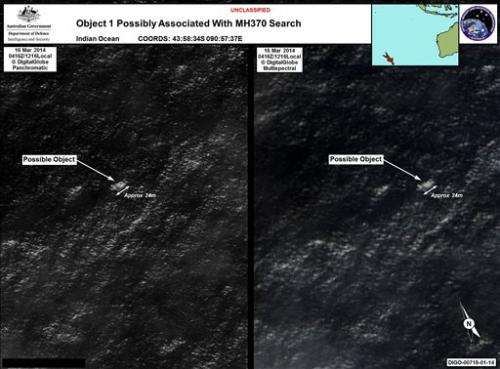Satellites searching for missing plane have limits

The satellites searching vast stretches of ocean for the missing Malaysia Airlines plane are not the stuff of Hollywood.
They can scan large areas for relatively small objects, but they have limitations.
That's why experts say images taken by a private-sector satellite company and released by the Australian government provide a clue that needs investigating, but they aren't conclusive evidence that the objects in the images are from the missing Boeing 777.
To the untrained eye, the two objects might look like large, white-capped waves in the open ocean. To the eyes of experts, they were sufficiently compelling to send four airplanes to search an area of the southern Indian Ocean.
"You know how they say a picture is worth 1,000 words? Well, in satellite imagery, the picture's only worth 500. The rest has to come from analysis," said Sean O'Connor, an imagery analyst with IHS Janes, a firm that specializes in the analysis of defense-related matters.
"It would be very nice if you could see a whole wing floating there, then you could say, 'OK that's an airplane,'" O'Connor said. "When you're looking at something like this, you can't tell what it is."
One of the objects was almost 80 feet (24 meters) long and the other was about 15 feet (5 meters) long, according to John Young, manager of the Australian Maritime Safety Authority's emergency response division. The images were taken March 16, but Australian officials say it took time to analyze them before they were released.
Young called it "the best lead we have right now."
The search was expected to resume at daylight in the area, about 7 p.m. Eastern time in the U.S.
The images came from a DigitalGlobe commercial satellite that scans the Earth from the north to south, said Tim Brown, a satellite imagery expert at GlobalSecurity.org in Alexandria, Va.
These kinds of satellites can look left to right, but the further they look to the side, the lower quality the images will be. There are other limitations. Because of their orbits, they can only scan a specific section of the Earth at certain times each day, much like the sun is only overhead part of the day.
Commercial satellites may be able to pick up stripes on a parking lot by using interpretation software and the contrast of the colors of the stripes and asphalt, but a similar size object in the ocean could easily be missed, said Joseph Bermudez Jr., chief analytics officer and co-founder AllSource Analysis, which specializes in satellite imagery.
They aren't like those in the movies that can, say, read a car's license plate from space. And the images are not going to be as clear as those taken by a drone, which is much closer to the Earth.
Governments have more powerful satellites, but those are classified and used for intelligence and national security, trained in the case of the United States on countries like North Korea and Iran, Brown said.
A Pentagon spokesman, Rear Adm. John Kirby, said that as far as he knows, the U.S. has received no specific requests to review its satellite data in response to the discovery in the southern Indian Ocean.
Analyzing satellite images requires an experienced eye, looking for something anomalous that may not mean much to most people. And that has to be filtered through whatever information may be available, like a possible route taken by the missing airplane.
Bermudez said it's apparent from the images that there is an object floating at or near the ocean's surface, but it could be trash unrelated to the plane, so people have to go check it out.
DigitalGlobe, a leading commercial provider of high-resolution Earth imagery, recently launched a crowdsourcing effort to locate the plane, which disappeared March 8 with 239 people on board. The effort, using a crowdsourcing platform called Tomnod, relies on Internet users to identify debris.
DigitalGlobe said in a statement that its understanding is the search area expanded to the southern Indian Ocean and waters near Australia in the last few days, "at which time the Australian government started combing through imagery of this extremely large area."
© 2014 The Associated Press. All rights reserved.





















